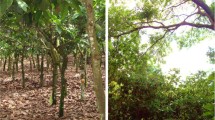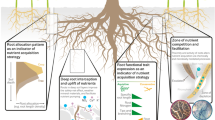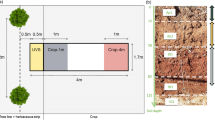Abstract
Agroforestry entails different life forms including mixtures of trees that occupy different soil strata and exhibit a certain degree of spatial complementarity in resource use. However, rigorous experimental studies characterising root interactions in tree–tree systems are notoriously few. We present here the available empirical evidence to support the hypothesis that occurrence of two or more tree species close to one another may favour diminished lateral spread and/or deeper root penetration of the woody components and closer the tree components are located greater will be the subsoil root activity. These evidences are based on either root excavation studies in coconut-based multistorey production systems, or 32P soil injection experiments involving binary mixtures of coconut+interplanted dicot multipurpose trees (Vateria indica, Ailanthus triphysa or Grevillea robusta), and bamboo (Bambusa bambos)+teak (Tectona grandis) or Malabar white pine (V. indica). The excavation study denotes a spatially segregated root distribution pattern of the component species. Furthermore, in the coconut + dicot tree system, interplanted dicot trees absorbed considerable quantities of the radio-label applied to the palm, which declined log-linearly with distance from the palms, signifying a substantial potential for “capturing” the lower leaching nutrients, at proximal distances. Likewise, lower teak/Vateria root activity in the surface horizons and higher activity in the deeper layers, when bamboo clumps were nearby and vice versa when they were farther apart, implied that proximity of species/individuals favoured competitive downward displacement of roots. Nutrient pumping and/or current transfer of nutrients between the rhizospheres of the two associated crops are also possible. In designing sustainable agroforestry systems, it is, therefore, advantageous to mix trees with divergent root growth habits.

Source Nelliat et al. (1974)

Adapted from Nelliat et al. (1974)


Adapted from Divakara et al. (2001)

Adapted from Divakara et al. (2001)

Similar content being viewed by others
References
Ahmed MFU, Rahman SML, Ahmed MASM, Quebedeaux B (2004) Agroforestry as it pertains to vegetable production in Bangladesh. J Agron 3:282–290
Allen S, Jose S, Nair PKR, Brecke BJ, Nkedi-Kizza P (2004) Safety net role of tree roots: experimental evidence from an alley cropping system. For Ecol Manag 192:395–407
Anilkumar KS, Wahid PA (1988) Root activity pattern of coconut palm. Oleagineux 43:337–342
Bessler H, Temperton VM, Roscher C, Buchmann N, Schmid B, Schulze E-D, Weisser WW, Engels C (2009) Aboveground over yielding in grassland mixtures is associated with reduced biomass partitioning to belowground organs. Ecology 90:1520–1530
Caldwell MM, Richards JH (1986) Competing root systems: morphology and models of absorption. In: Givnish T (ed) On the economy of plant form and function. Cambridge University, Cambridge, pp 251–273
Caldwell MM, Manwaring JH, Durham SL (1991) The microscale distribution of neighboring plant roots in fertile soil microsites. Funct Ecol 5:765–772
Callaway RM, Pennings SC, Richards CL (2003) Phenotypic plasticity and interactions among plants. Ecology 84(5):1115–1128
Cannell MGR, Malcolm DC, Robertson PA (1992) The ecology of mixed species stands of trees. Blackwell, London
Cannell MGR, Van Noordwijk M, Ong CK (1996) The central agroforestry hypothesis: the trees must acquire resources that the crop would not otherwise acquire. Agrofor Syst 34:27–31
Casper BB, Jackson RB (1997) Plant competition underground. Annu Rev Ecol Syst 28:545–570
Clements FE, Weaver JE, Hanson HC (1929) Plant competition. Carnegie Institution Washington, Washington, p 398
Coomes DA, Grubb PJ (1998) Responses of juveniles to above- and belowground competition in nutrient-starved Amazonian rainforests. Ecology 79:768–782
Divakara BN, Kumar BM, Balachandran PV, Kamalam NV (2001) Bamboo hedgerow systems in Kerala, India: root distribution and root competition with trees for phosphorus. Agrofor Syst 51:189–200
Drew MC, Saker LR (1975) Nutrient supply and the growth of the seminal root system in barley. II. Localized compensatory increases in lateral root growth and rates of nitrate uptake when nitrate is restricted to only part of the root system. J Exp Bot 26:79–90
Emerman SH, Dawson TE (1996) Hydraulic lift and its influence on the water content of the rhizosphere: an example from sugar maple, Acer saccharum. Oecologia 108:273–278
Faget M, Nagel KA, Walter A, Herrera JM, Jahnke S, Schurr U, Temperton VM (2013) Root–root interactions: extending our perspective to be more inclusive of the range of theories in ecology and agriculture using in vivo analyses. Ann Bot 112:253–266
Fernandez ME, Gyenge J, Licata J, Schlichter T, Bond BJ (2008) Belowground interactions for water between trees and grasses in a temperate semiarid agroforestry system. Agrofor Syst 74:185–197
Fletcher EH, Thetford M, Sharma J, Jose S (2012) Effect of root competition and shade on survival and growth of nine woody plant taxa within a Pecan (Carya illinoinensis K. Koch.) alley cropping system. Agrofor Syst 86:49–60
Gause GF (1934) The struggle for existence. http://www.ggause.com/Contgau.htm. Accessed 21 Aug 2016
George SJ, Kumar BM, Wahid PA, Kamalam NV (1996) Root competition for phosphorus between the tree and herbaceous components of silvopastoral systems in Kerala, India. Plant Soil 179:189–196
Ghosh SP, Kumar BM, Kabeerathumma S, Nair GM (1989) Productivity, soil fertility and soil erosion under cassava based agroforestry systems. Agrofor Syst 8:67–82
Gowda HBS, Kumar BM (2008) Root competition for phosphorus between coconut palms and interplanted dicot trees along a soil fertility gradient. In: Jose S, Gordon A (eds) Towards agroforestry design: an ecological approach. advances in agroforestry series, vol 4. Springer, Dordrecht, pp 175–193
Hagan D, Jose S (2011) Interspecific competition enhances nitrogen fixation in an actinorhizal shrub. Plant Ecol 212:63–68
Hagan DL, Jose S, Thetford M, Bohn K (2010) Partitioning of applied 15N fertilizer in a longleaf pine and native woody ornamental intercropping system. Agrofor Syst 79:47–57
Harper JL (1977) Population biology of plants. Academic Press, New York
Hauggaard-Nielsen H, Jensen ES (2005) Facilitative root interactions in intercrops. Plant Soil 274:237–250
Jackson RB, Caldwell MM (1989) The timing and degree of root proliferation in fertile-soil microsites for three cold-desert perennials. Oecologia 81:149–153
Jamaludheen V, Kumar BM, Wahid PA, Kamalam NV (1997) Root distribution pattern of the wild jack tree (Artocarpus hirsutus Lamk.) using 32P soil injection method. Agrofor Syst 35:329–336
Jose S, Gillespie AR, Seifert J, Biehle DJ (2000) Defining competition vectors in a temperate alley cropping system in the mid-western USA. 2. Competition for water. Agrofor Syst 48:41–59
Jose S, Gillespie AR, Pallardy SG (2004) Interspecific interactions in temperate agroforestry. Agrofor Syst 61:237–255
Jose S, Williams R, Zamora D (2006) Belowground ecological interactions in mixed-species forest plantations. For Ecol Manag 233:231–239
Kumar BM (2007) Coconut-based agroforestry for productive and protective benefits. In: Thampan PK ,Vasu KI (eds) Coconut for rural welfare. proceedings of international coconut summit 2007, Kochi, India. Asian and Pacific Coconut Community, Jakarta, pp 87–98
Kumar BM, Divakara BN (2001) Proximity, clump size and root distribution pattern in bamboo: a case study of Bambusa arundinacea (Retz.) Willd., Poaceae, in the Ultisols of Kerala, India. J Bamboo Rattan 1:43–58
Kumar SS, Kumar BM, Wahid PA, Kamalam NV, Fisher RF (1999) Root competition for phosphorus between coconut, multipurpose trees and kacholam (Kaempferia galanga) in Kerala, India. Agrofor Syst 46:131–146
Kumar BM, Kumar SS, Fisher RF (2005) Galangal growth and productivity related to light transmission in single-strata, multistrata and ‘no-over-canopy’ systems. J New Seeds 7(2):111–126
Lehmann J (2003) Subsoil root activity in tree-based cropping systems. Plant Soil 255:319–331
Lehmann J, Peter I, Steglich C, Gebauer G, Huwe B, Zech W (1998) Below-ground interactions in dryland agroforestry. For Ecol Manag 111:157–169
Liyanage M de S, Jayasundara HPS, Perera KCP (1990) Studies on the biomass productivity of selected multipurpose trees. In: Gunasena HPM (ed) Proceedings of first regional workshop on multipurpose trees, Kandy, pp 27–36
Lyford WH, Wilson BF (1964) Development of the root system of Acer rubrum L. Harvard Forestry Paper 10:1–17
Mackenthum G (1990) Vergleichende Okologische Untersuchung eines Fichten- Buchen-Mischbestandes and verschiedener Reinbestande in Weterhof. In: Harzvorland, Diplomarbeit, Universitat Gottingen, Gottingen
Malézieux E, Crozat Y, Dupraz C, Laurans M, Makowski D, Ozier-Lafontaine H, Rapidel B, de Tourdonnet S, Valantin-Morison M (2009) Mixing plant species in cropping systems: concepts, tools and models. A review. Agron Sustain Dev 29:43–62
Menalled FD, Kelty MJ, Ewel JJ (1998) Canopy development in tropical tree plantations: a comparison of species mixtures and monocultures. For Ecol Manag 104:249–263
Mommer L, van Ruijven J, De Caluwe H, Smit-Tiekstra AE, Wagemaker CAM, Ouborg NJ, Bogemann GM, van der Weerden GM, Berendse F, de Kroon H (2010) Unveiling belowground species abundance in a biodiversity experiment: a test of vertical niche differentiation among grassland species. J Ecol 98:1117–1127
Nair PKR (1979) Intensive multiple cropping with coconuts in India. Paul Parey, Berlin, p 148p
Nair VD, Graetz DA (2004) Agroforestry as an approach to minimizing nutrient loss from heavily fertilized soils: the Florida experience. Agrofor Syst 61:269–279
Nair PKR, Nair VD, Kumar BM, Showalter JM (2010) Carbon sequestration in agroforestry systems. Adv Agron 108:237–307. doi:10.1016/S0065-2113(10)08005-3
Nambiar EKS, Sands R (1993) Competition for water and nutrients in forests. Can J For Res 23(10):1955–1968
Nelliat EV, Bavappa KVA, Nair PKR (1974) Multi-storeyed cropping—new dimension of multiple cropping in coconut plantations. World Crops 26:262–266
Niranjana KS, Viswanath S (2008) Root characteristics of tea [Camellia sinensis (L.) O. Kuntze] and silver oak [Grevillea robusta (A. Cunn)] in a mixed tea plantation at Munnar, Kerala. J Trop Agric 46 46(1–2):25–31
Nye PH, Tinker PB (1977) Solute movement in the soil system. Blackwell, Oxford, p 432
Ong CK, Leakey RRB (1999) Why tree-crop interactions in agroforestry appear at odds with tree-grass interactions in tropical savannahs. Agrofor Syst 45:109–129
Ong CK, Black CR, Marshall FM, Corlett JE (1996) Principles of resource capture and utilization of light and water. In: Ong CK, Huxley P (eds) Tree-crop interactions: a physiological approach. CAB International, Wallingford, pp 73–158
Ong CK, Kho RM, Radersma S (2004) Ecological interactions in multispecies agroecosystems: concepts and rules. In: van Noordwijk M, Cadisch G, Ong CK (eds) Belowground interactions in tropical agroecosystems. CAB International, Wallingford, pp 1–15
Pandey CB, Begum M, Singh SK, Saha D (2014) Coconut-based homegardens: mechanisms of complementarity in sharing of growth resources among homegarden trees in the South Andaman Islands of India. Trop Ecol 55(3):339–348
Putz FE, Parker GG, Archibald RM (1984) Mechanical abrasion and inter crown spacing. Am Midl Nat 112:24–28
Rockwood DL, Naidu CV, Carter DR, Rahmani M, Spriggs TA, Lin C, Alker GR, Isebrands JG, Segrest SA (2004) Short-rotation woody crops and phytoremediation: opportunities for agroforestry? Agrofor Syst 61:51–63
Rowe EC, Hairiah K, Giller KE, van Noordwijk M, Cadisch G (1999) Testing the safety-net role of hedgerow tree roots by 15N placement at different soil depths. Agrofor Syst 43:81–93
Rysavy T, Roloff A (1994) Ursachen der Vereschung in Mischbestanden und Vorschlage zu iher Vermeidung. For. Holz. 49:392–395
Schenk HJ (2006) Root competition: beyond resource depletion. J Ecol 94:725–739
Schenk HJ, Callaway RM, Mahall BE (1999) Spatial root segregation: are Plants territorial? Adv Ecol Res 28:145–180
Schroth G (1999) A review of below ground interactions in agroforestry, focussing on mechanisms and management options. Agrofor Syst 43:5–34
Thomas J, Kumar BM, Wahid PA, Kamalam NV, Fisher RF (1998) Root competition for phosphorus between ginger and Ailanthus triphysa in Kerala, India. Agrofor Syst 41:293–305
van Noordwijk M, Cadisch G (2002) Access and excess problems in plant nutrition. Plant Soil 247:25–40
van Noordwijk M, Purnomosidhi P (1995) Root architecture in relation to tree-soil-crop interactions and shoot pruning in agroforestry. Agroforest Syst 30:161–173
van Noordwijk M, Hairiah K, Syekhfani MS, Flach EN (1991) Peltophorum pterocarpa (DC) Back (Caesalpiniaceae), a tree with a root distribution suitable for alley cropping on acid soils in the humid tropics. In: McMichael BL, Persson H (eds) Plant roots and their environment. Elsevier, Amsterdam, pp 526–532
van Noordwijk M, Lawson G, Hairiah K, Wilson J (2015) Root distribution of trees and crops: competition and/or complementarity. In: Ong CK, Black CR, Wilson J (eds) Tree-crop interactions: agroforestry in a changing climate, 2nd edn. CAB International, Wallingford, pp 221–257
Vose PB (1980) Introduction to nuclear techniques in agronomy and plant biology. Pergamon, Oxford, p 391
Wahid PA (2001) Radioisotope studies of root activity and root-level interactions in tree-based production systems: a review. Appl Radiat Isot 54(5):715–736
Wahid PA, Kamalam NV, Ashokan PK, Nalr RV (1989a) Root activity pattern of cocoa (Theobroma cacao). J Nuclear Agric Biol 18:153–156
Wahid PA, Kamalam NV, Ashokan PK, Vidyadharan KK (1989b) Root activity patterns of cashew (Anacardium occidentale) in laterite soil. J Plant Crops 17:85–89
Wiersum LK (1958) Density of root branching as affected by substrate and separate ions. Acta Bot 7:174–179
Wittkopf W (1995) Wurzelintensitat im Fichten-Buchen-Mischbenstand im Vergleich zum Reinbestand Diplomarbeit Forstwissenschaftliche Fakultaet, Universitaet Munchen, Munchen
Lamanda N, Malézieux E, Martin P (2006) Structure and dynamics of coconut-based agroforestry systems in melanesia: a case study from vanuatu archipelago. In: Kumar BM, Nair PKR (eds) Tropical homegardens: a time-tested example of sustainable agroforestry. Springer, Dordretch, pp 105–122
Zamora D, Jose S, Nair PKR (2007) Morphological plasticity of cotton roots in response to interspecific competition with pecan in an alleycropping system in the southern United States. Agrofor Syst 69:107–116
Acknowledgments
This paper was written when the senior author was on a sabbatical at the University of Missouri, Columbia, MO (UMC). Financial support provided by Nalanda University (Faculty Development Allowance) and the Center for Agroforestry, UMC (Visiting Scholar Programme) to the senior author, are gratefully acknowledged.
Author information
Authors and Affiliations
Corresponding author
Rights and permissions
About this article
Cite this article
Kumar, B.M., Jose, S. Phenotypic plasticity of roots in mixed tree species agroforestry systems: review with examples from peninsular India. Agroforest Syst 92, 59–69 (2018). https://doi.org/10.1007/s10457-016-0012-2
Received:
Accepted:
Published:
Issue Date:
DOI: https://doi.org/10.1007/s10457-016-0012-2




